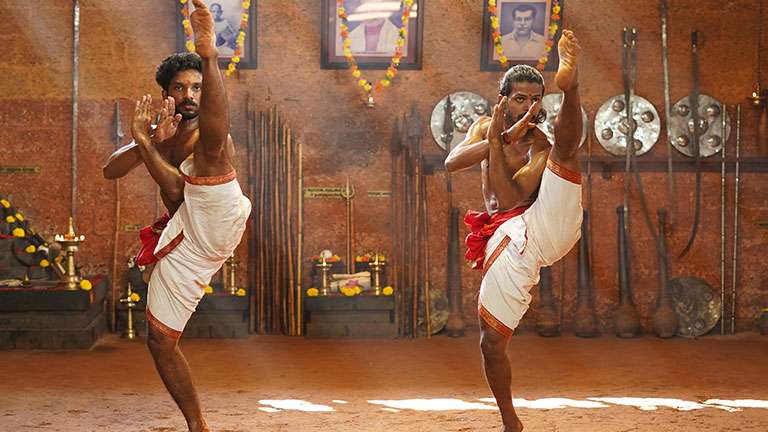



Kalaripayattu, also spelled as Kalarippayattu is an ancient martial art indigenous to Kerala, a small state in the southern tip of India, but is known and practised throughout the globe today. The exact time of its origin however cannot be fixed with any sense of certainty. Some argue that in its crudest form, Kalaripayattu was a means by which the earliest inhabitants of this wooded and mountainous terrain hunted wild animals before it was refined into a systematic mode of combat that was effective enough to overpower enemies and defend themselves. Myth-lovers like to believe that Kalaripayattu has a hoary past, having been introduced by Lord Parasurama, the sixth incarnation of Lord Vishnu, after he reclaimed the land of Kerala from the Arabian Sea. While historians reject such claims, there is no consensus among them either, with their pegging the time of its birth anywhere between 200 BCE and 600 CE, and its cresting popularity between the 14th and 16th centuries. But what has never varied, amidst all these claims and counter-claims, is the awe with which chroniclers and poets of different periods recorded the complexity of the techniques, the liquid beauty of the moves, and the enviable elasticity of the practitioners of Kalaripayattu. With very little physical evidence to ascertain its point of origin, if one looks elsewhere, one finds specific references to Kalaripayattu in songs that for a long time had only an oral tradition to speak of. It has to be inferred that some form of Kalaripayattu was taught virtually in every village in Kerala because there is frequent mention of great masters who supervised the activities of a hundred and eight kalaris or training centres/arenas, and there are numerous allusions to house names like “Kalaripparambu” and “Kalariyullathil” that openly point to the connection with this martial art. Kalaris were invariably situated near Devi temples, and the master used to be called “Kuruppu” or “Gurukkal”. Traditionally, expertise in Kalarippayattu has been associated with machismo, and in olden times, those who could not wield the sword were considered lacking in masculinity and hence deserved to live only like slaves. However, there are references to women warriors too who could match their male counterparts in all aspects of the martial art.

The Vadakkan Paattukal [ballads of North Malabar] and the Thekkan Paattukal [ballads of South Kerala] not only tell stories of numerous battles waged between princely states, but also of feuds fought between families and clans with the help of experts in Kalaripayattu, who were either members of the warring groups or mercenaries employed by them. It also gives verbal portraits of exceptionally heroic figures as well. The exploits of brave warriors like Thacholi Othennan, Aromal Chekavar, Kannappa Chekavar, and Unniyarcha narrated in the Vadakkan Paattukal, and those of Idanaadan and Iravikutty Pillai in Thekkan Paattukal are so vivid as to give them a semi-divine aura. It is rare to find a Malayali who has not been fed on accounts of their legendary skill and courage. They even feature in Theyyam and Thira, the ritualistic folk art forms popular in Malabar [the northernmost region of Kerala]. At various times in the history of modern Kerala, their lives have been presented and the motives behind their actions subversively interpreted through many a blockbuster movie. Such has been the influence of Kalaripayattu that many of its moves can be seen choreographed in dances performed by Hindus, Muslims and Christians – like Poorakkali, Kolkali and Chavittu Natakam, ritualistic dance forms like Parichamuttukali, Patayani and Mudiyettu as well as the dance-drama of Kathakali, in which combat moves have been stylized to give them a stronger aesthetic appeal. Through the centuries, the services of Kalaripayattu experts were sought to form the armed retinue of rulers of princely states to conduct duels in order to settle inheritance disputes between male members of aristocratic families, to take revenge on chronic enemies, or even to settle personal scores. Although Kalaripayattu gave birth to numerous combatants who were invincible in the arena, in the course of time, it proved no match for relatively modern war techniques that were unleashed on the state by invaders from neighbouring provinces (like Hyder Ali and Tipu Sultan in the 18th century) and later by colonizers from overseas (like the Portuguese, the Dutch and the British). This led to a decline in its popularity and practice until the freedom struggle led by K. Kelappan in Kerala paved the way for its revival. The restoration of this ancient martial art if not to its former glory but at least to a respectable position in popular imagination was possible because of the silent dedication of many who pursued it passionately through its years of suspended animation and near oblivion.
Department of Tourism, Government of Kerala, Park View, Thiruvananthapuram, Kerala, India - 695 033
Phone: +91 471 2321132, Fax: +91 471 2322279, E-mail: info@keralatourism.org.
All rights reserved © Kerala Tourism 2026. Copyright | Terms of Use | Cookie Policy | Contact Us. Developed & Maintained by Invis.